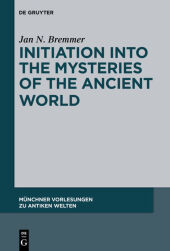 Neuerscheinungen 2014Stand: 2020-02-01 |
Schnellsuche
ISBN/Stichwort/Autor
|
Herderstraße 10
10625 Berlin
Tel.: 030 315 714 16
Fax 030 315 714 14
info@buchspektrum.de |

Jan N. Bremmer
Initiation into the Mysteries of the Ancient World
2014. XVIII, 256 S. 230 mm
Verlag/Jahr: DE GRUYTER 2014
ISBN: 3-11-029929-1 (3110299291)
Neue ISBN: 978-3-11-029929-8 (9783110299298)
Preis und Lieferzeit: Bitte klicken
Das Münchner Zentrum für Antike Welten ist eine interfakultäre Arbeitsgemeinschaft an der Ludwig-Maximilians-Universität. Es verfügt über eine ständige Gastprofessur für antike Kulturgeschichte. Auf sie werden im jährlichen Wechsel namhafte Gelehrte aus den Altertumswissenschaften berufen, die in einer Vortragsreihe ein interdisziplinär bedeutsames Thema behandeln. Zudem veranstaltet das MZAW Kolloquien und Fachtagungen. Die Reihe Münchner Vorlesungen zu Antiken Welten legt diese Vorträge einem kultur- und altertumswissenschaftlich interessierten Publikum vor.
The "Münchner Zentrum für Antike Welten" is a joint research center at the LMU in Munich with a permanent visiting professorship. Each year an internationally renowned scholar of Ancient Studies is invited to hold a lecture series on significant interdisciplinary topics. Furthermore, the MZAW organizes congresses and conferences. The series presents these lectures to an audience interested in the history and culture of the ancient world.
The ancient Mysteries have long attracted the interest of scholars, an interest that goes back at least to the time of the Reformation. After a period of interest around the turn of the twentieth century, recent decades have seen an important study of Walter Burkert (1987). Yet his thematic approach makes it hard to see how the actual initiation into the Mysteries took place. To do precisely that is the aim of this book. It gives a ´thick description´ of the major Mysteries, not only of the famous Eleusinian Mysteries, but also those located at the interface of Greece and Anatolia: the Mysteries of Samothrace, Imbros and Lemnos as well as those of the Corybants. It then proceeds to look at the Orphic-Bacchic Mysteries, which have become increasingly better understood due to the many discoveries of new texts in the recent times. Having looked at classical Greece we move on to the Roman Empire, where we study not only the lesser Mysteries, which we know especially from Pausanias, but also the new ones of Isis and Mithras. We conclude our book with a discussion of the possible influence of the Mysteries on emerging Christianity. Its detailed references and up-to-date bibliography will make this book indispensable for any scholar interested in the Mysteries and ancient religion, but also for those scholars who work on initiation or esoteric rituals, which were often inspired by the ancient Mysteries.
Jan N. Bremmer, University of Groningen.


